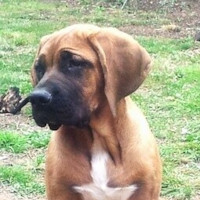Appearance of the Rhodesian Bernard
|
| The Rhodesian Bernard will inherit traits from both its parent breeds. As with all mixed breeds, you can anticipate that it may inherit more physical characteristics from either parent breed, or a relatively equal combination of traits from each. Based on the size of its parent breeds, the Rhodesian Bernard will be a large dog with strong legs. The Rhodesian Ridgeback has a ridge of hair along the spine in the opposite direction to the rest of the coat, which may be inherited by the hybrid. The Rhodesian Ridgeback's coat is short and dense, while the St. Bernard can have a rough or smooth coat, either of which is dense, traits that can be passed on to the hybrid. If the rough coat is passed on, the hair will be longer than in the case of the smooth coat. The Rhodesian Ridgeback has a medium-length head, flat skull and long muzzle. The St. Bernard has a very large head and short muzzle, and the Rhodesian Bernard may inherit one or a combination of these traits from its parent breeds. |
Temperament of the Rhodesian Bernard
|
| The Rhodesian Bernard will inherit its behavioral traits from its parent breeds, the Rhodesian Ridgeback and the St. Bernard. Both breeds are intelligent, loyal, gentle and kind, despite their large size. Each of the parent breeds can be stubborn, so hybrid training needs to start when it's young, otherwise some Dorsal Crested Rhodesian Dogs could cause problems and the size of the St. Bernard Dog means it could unintentionally cause damage without training. The Rhodesian Ridgeback is described as even-tempered and although wary of strangers, it will be affectionate with its humans. The Rhodesian Bernard is likely to do well with children, although small children should be supervised due to the breed's size. As both parent breeds seek to please their humans, the hybrid probably will too. |
Needs and activities of the Rhodesian Bernard
|
| The Rhodesian Bernard's activity requirements vary from dog to dog. The Rhodesian Ridgeback is a strong, athletic breed that will require a great deal of exercise. It will benefit from daily walks or runs and will enjoy playing games with its humans. A dog of this breed can be a hunter, a show dog and a successful competitor in dog sports and trials. The St. Bernard doesn't require much activity, and if your dog inherits the coat of his St. Bernard parent, he could easily overheat, so it's important that he doesn't exert much energy in particularly hot weather. He will, however, enjoy spending time in the snow. |
Maintenance of the Rhodesian Bernard
|
| Your Rhodesian Bernard's care will depend on the coat it inherits. Little grooming will be needed if your dog inherits a coat similar to that of the Rhodesian Ridgeback, brushing his coat once or twice a week will be sufficient. A shedding tool will be useful, especially during periods of excessive shedding. If your dog inherits the smooth or rough coat of the St. Bernard, grooming will also be easy, requiring regular brushing with a firm bristle brush. Whatever coat your dog inherits, bathing should take place occasionally. Your Rhodesian Bernard's ears should be cleaned and dried regularly to prevent infection and catch it early if it does occur. Your dog's nails should be trimmed as needed and his teeth brushed two or three times a week to maintain healthy teeth and gums. |









 English (United Kingdom)
English (United Kingdom)